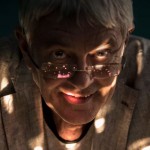Aussie experts respond to claims this optical illusion could become an autism test
Posted on
How you see this simple optical illusion, and more importantly how your brain sees it, could reveal a lot about you.
One day, it’s claimed, the rotating dots may even be used as a tool to help diagnose autism.
Watch the dots spin for a moment. Nearly everyone sees a spinning hollow cylinder, black on one side and white on the other, randomly changing direction.
Click here to see the optical illusion
But not everyone’s brain is processing the image in the same way.
Of course, there is no cylinder per se – just 300 dots moving from side to side, switching from black to white.
The typical brain takes in the big picture, ignoring the details.
But to the brains of people with high levels of attention to detail, it’s just dots.
David Burr and his collaborators have been showing this illusion to university students in Pisa and Florence, in Italy, over the past year. In a clever experiment, they have tracked the size of the students’ pupils with an infrared camera as they watch the cylinder spin.
“Everybody reports the spontaneous and unpredictable changes in the cylinder’s direction,” says Professor Burr, who now works at the University of Sydney. “But not everyone perceives the figure in the same way.”
Using the illusion, Professor Burr’s team was able to use the viewer’s pupil into a marker for how their mind is processing information.
Pupils contract and expand, like the iris of a camera, to control how much light hits the retina.
The overall darkness of the cylinder does not change. If you’re paying attention to the whole picture, your pupil won’t move.
The brains of these responders are focusing their attention on the individual surfaces of the cylinder, rather than the cylinder as a whole. Even if they don’t ‘see’ it, their brain is focused on detail, rather than the bigger picture.
Professor Burr went a step further – he demonstrated the traits revealed by the illusion seemed to be mirrored in people’s personalities and thinking styles.
As part of Professor Burr’s study, published this week in eLife, subjects also took a self-administered test of autistic traits.
Those who saw the dots, not the big picture, tended to score much higher – which makes sense, the professor believes, because autism is characterised by extreme attention to detail.
If the study can be repeated using more people – Professor Burr tested only 50 – and on people diagnosed with autism, he thinks it might become a useful diagnosis tool for autism.
Others aren’t convinced. “This is not a particularly strong study, it’s not even talking about an autistic population,” says Professor Cheryl Dissanayake, director of the Olga Tennison Autism Research Centre.
That said, people with autism do tend to excel at spotting fine details and pattern recognition while struggling to see the overall structure of something.
“When we come out of the womb, humans perceive the world in a particular way. We focus on social information, such as faces and eyes,” says Professor Andrew Whitehouse, chief research officer at the Autism Cooperative Research Centre.
“If we’re not perceiving the world in that typical way right from the get go, then of course our development will be different.
“There is a theory that kids aren’t necessarily ‘born’ with autism, they are born with subtle differences in the way they perceive the world. From that point of view, autism is a perfectly normal response to a different starting point in life.”

